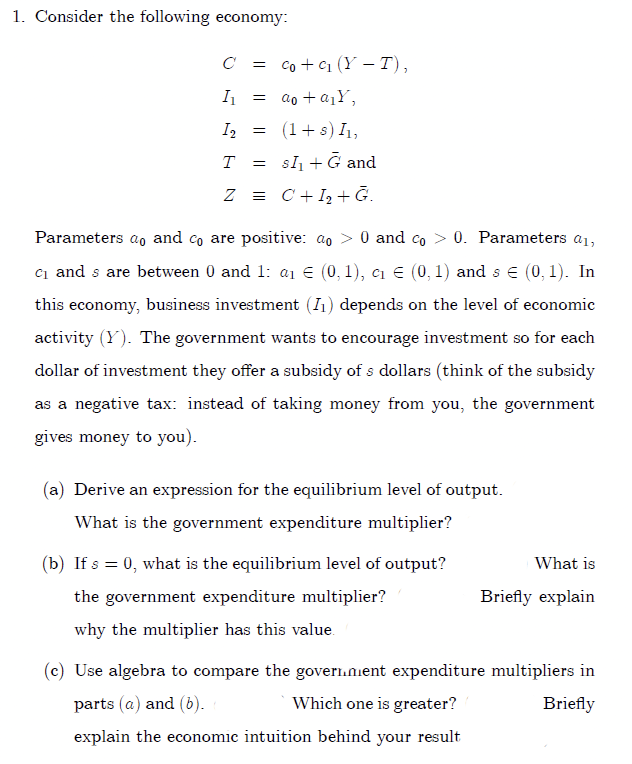1. Consider the following economy: C = co + c1 (Y – T), I = ao +aY, I, = (1+ s) I1, T = sI + G and Z = C+I2 + Ğ. Parameters ao and co are positive: ao > 0 and co > 0. Parameters a1, ci and s are between 0 and 1: ai € (0, 1), cı € (0, 1) and s e (0, 1). In this economy, business investment (I1) depends on the level of economic activity (Y). The government wants to encourage investment so for each dollar of investment they offer a subsidy of s dollars (think of the subsidy as a negative tax: instead of taking money from you, the government gives money to you). (a) Derive an expression for the equilibrium level of output. What is the government expenditure multiplier? (b) If s = 0, what is the equilibrium level of output? What is the government expenditure multiplier? Briefly explain why the multiplier has this value. (c) Use algebra to compare the goveri.nient expenditure multipliers in parts (a) and (b). Which one is greater? Briefly explain the economic intuition behind your result
1. Consider the following economy: C = co + c1 (Y – T), I = ao +aY, I, = (1+ s) I1, T = sI + G and Z = C+I2 + Ğ. Parameters ao and co are positive: ao > 0 and co > 0. Parameters a1, ci and s are between 0 and 1: ai € (0, 1), cı € (0, 1) and s e (0, 1). In this economy, business investment (I1) depends on the level of economic activity (Y). The government wants to encourage investment so for each dollar of investment they offer a subsidy of s dollars (think of the subsidy as a negative tax: instead of taking money from you, the government gives money to you). (a) Derive an expression for the equilibrium level of output. What is the government expenditure multiplier? (b) If s = 0, what is the equilibrium level of output? What is the government expenditure multiplier? Briefly explain why the multiplier has this value. (c) Use algebra to compare the goveri.nient expenditure multipliers in parts (a) and (b). Which one is greater? Briefly explain the economic intuition behind your result
Economics: Private and Public Choice (MindTap Course List)
16th Edition
ISBN:9781305506725
Author:James D. Gwartney, Richard L. Stroup, Russell S. Sobel, David A. Macpherson
Publisher:James D. Gwartney, Richard L. Stroup, Russell S. Sobel, David A. Macpherson
Chapter27: Investment, The Capital Market, And The Wealth Of Nations
Section: Chapter Questions
Problem 14CQ
Related questions
Question
!

Transcribed Image Text:1. Consider the following economy:
C =
co + c1 (Y – T),
II =
= ao + a1Y,
I2
(1+s) I1,
T
=
sl + G and
Z = C+I2 + Ğ.
Parameters a and co are positive: ao > 0 and co > 0. Parameters a1,
ci and s are between 0 and 1: a1 € (0, 1), cı E (0, 1) and s e (0, 1). In
this economy, business investment (I1) depends on the level of economic
activity (Y). The government wants to encourage investment so for each
dollar of investment they offer a subsidy of s dollars (think of the subsidy
as a negative tax: instead of taking money from you, the government
gives money to you).
(a) Derive an expression for the equilibrium level of output.
What is the government expenditure multiplier?
(b) If s = 0, what is the equilibrium level of output?
What is
the government expenditure multiplier?
Briefly explain
why the multiplier has this value.
(c) Use algebra to compare the goveri.nient expenditure multipliers in
parts (a) and (6).
Which one is greater?
Briefly
explain the economic intuition behind your result
Expert Solution
This question has been solved!
Explore an expertly crafted, step-by-step solution for a thorough understanding of key concepts.
Step by step
Solved in 3 steps with 6 images

Recommended textbooks for you

Economics: Private and Public Choice (MindTap Cou…
Economics
ISBN:
9781305506725
Author:
James D. Gwartney, Richard L. Stroup, Russell S. Sobel, David A. Macpherson
Publisher:
Cengage Learning

Microeconomics: Private and Public Choice (MindTa…
Economics
ISBN:
9781305506893
Author:
James D. Gwartney, Richard L. Stroup, Russell S. Sobel, David A. Macpherson
Publisher:
Cengage Learning

Principles of Economics 2e
Economics
ISBN:
9781947172364
Author:
Steven A. Greenlaw; David Shapiro
Publisher:
OpenStax

Economics: Private and Public Choice (MindTap Cou…
Economics
ISBN:
9781305506725
Author:
James D. Gwartney, Richard L. Stroup, Russell S. Sobel, David A. Macpherson
Publisher:
Cengage Learning

Microeconomics: Private and Public Choice (MindTa…
Economics
ISBN:
9781305506893
Author:
James D. Gwartney, Richard L. Stroup, Russell S. Sobel, David A. Macpherson
Publisher:
Cengage Learning

Principles of Economics 2e
Economics
ISBN:
9781947172364
Author:
Steven A. Greenlaw; David Shapiro
Publisher:
OpenStax